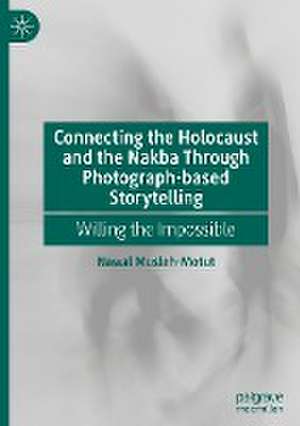Connecting the Holocaust and the Nakba Through Photograph-based Storytelling: Willing the Impossible
Autor Nawal Musleh-Motuten Limba Engleză Hardback – 16 mai 2023
Preț: 888.50 lei
Preț vechi: 1083.54 lei
-18% Nou
Puncte Express: 1333
Preț estimativ în valută:
170.13€ • 175.50$ • 141.00£
170.13€ • 175.50$ • 141.00£
Carte tipărită la comandă
Livrare economică 21 februarie-07 martie
Preluare comenzi: 021 569.72.76
Specificații
ISBN-13: 9783031272370
ISBN-10: 3031272374
Ilustrații: XVI, 328 p. 36 illus. in color.
Dimensiuni: 148 x 210 mm
Greutate: 0.56 kg
Ediția:2023
Editura: Springer International Publishing
Colecția Palgrave Macmillan
Locul publicării:Cham, Switzerland
ISBN-10: 3031272374
Ilustrații: XVI, 328 p. 36 illus. in color.
Dimensiuni: 148 x 210 mm
Greutate: 0.56 kg
Ediția:2023
Editura: Springer International Publishing
Colecția Palgrave Macmillan
Locul publicării:Cham, Switzerland
Cuprins
Part I The Task in Hand & A Challenge Accepted.- 1. Introduction.- 2. An Impossible Yet Necessary Task.- 3. Willing the Impossible Through Storytelling & Photography.- Part II Nostalgia, Continuous Hauntings & Melancholic Resilience.- 4. Nick.- 5. Haifa Staiti.- 6. Amanda Qumsieh.- Part III Re-Education, Co-Memory & Melancholia.- 7. Ran Vered.- 8. Itai Erdal.- 9. Ofira Roll.- Part IV Willing The Impossible In The Contemporary Moment & Beyond.- 10. The Complete Consort Dancing Together Contrapuntally.- 11. Willing the Impossible in the Contemporary Moment.- 12. Reflections on an Intentionally Utopian Ethnographic Project.
Notă biografică
Nawal Musleh-Motut is a Postdoctoral Fellow in Social Justice and Decolonization with Transforming Inquiry into Learning and Teaching (TILT) and a Term Lecturer in the School of Communication, both at Simon Fraser University (SFU) in Burnaby, British Columbia, Canada.
Textul de pe ultima copertă
This unprecedented ethnographic study introduces a unique photography-based storytelling method that brings together everyday Palestinians and Israelis to begin connecting rather than comparing their distinct yet organically connected histories of suffering and exile resulting from the Holocaust and the Nakba. Working with Palestinians and Israelis living in their respective Canadian diasporas who are of the Holocaust and Nakba postmemory generations–those who did not experience these traumas but are nonetheless haunted by them–this study demonstrates that storytelling and photography enable the occasions and conditions of possibility necessary for willing the impossible. That is, by narrating and then exchanging their (post)memories of the Holocaust and/or the Nakba through associated vernacular photographs, project participants were able to connect rather than compare their histories of suffering and exile; take moral, ethical, and political responsibility for one another; and imagine new forms of cohabitation grounded in justice and equitable rights for all.
Nawal Musleh-Motut is a Postdoctoral Fellow in Social Justice and Decolonization with Transforming Inquiry into Learning and Teaching (TILT) and a Term Lecturer in the School of Communication, both at Simon Fraser University (SFU) in Burnaby, British Columbia, Canada.
Caracteristici
Introduces a unique photography-based storytelling method to bring together Palestinians and Israelis Demonstrates that storytelling and photography enable participants to imagine the new forms of cohabitation Draws on an emerging literature that seeks to put the memories and traumas of the Holocaust and Nakba in conversation
